CONSTELLATION GUIDE
Last updated: 13 October 2001
CONSTELLATION GUIDE |
"GO TO"....TAURUS
....the brilliant field of stars that's bullish by nature....
From: sherrodc@ipa.net (Clay Sherrod)
The striking constellation of TAURUS, the "Bull," is appropriately our landmark 30th Constellation Guide of the series "GO TO GUIDES for the ETX, LX 90 and all GO TO Telescopes. This wonderful and brilliant constellation is benchmarked by the bright fiery red star ALDEBARAN and the two closest star clusters and asterisms, the HYADES (Mel 25) and the PLEIADES (Messier 45). Because this star-rich constellation is located immediately west of the star clouds of the winter Milky Way, it is embedded in wonderful star groups and associations, and wonderful deep sky objects.
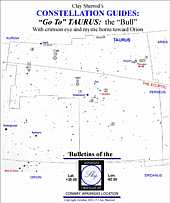
Because Taurus precedes the brilliant winter constellation of Orion in the sky, the advent of the bright red star ALDEBARAN is a benchmark for the thrilling views of winter skies. This "eye of the bull" clearly marks the asterism - and physical star cluster - the HYADES, a very easy-to-differentiate "V" shaped asterism of brilliant stars. As a matter of fact, this cluster is a wonderful method through which you can determine the LIMITING MAGNITUDE of the naked eye, binoculars and even the finderscope that is installed on your telescope using this cluster. (see my discussion of this topic at: http://www.weasner.com/etx/buyer-newuser-tips/magnitude.html ) . The diagram below shows my revised star catalog, with appropriate magnitudes of brighter stars of this cluster which may be identified in optics of 50mm and smaller, all the way to the naked eye. You can double click on this image and save to file and then print and laminate for a very handy reference to use in determining your limiting magnitude on any given night!
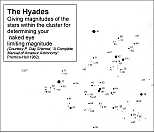
Likewise, to TEST critically the limiting magnitude of your telescope, you can use the next chart of the PLEIADES, also conveniently located in Taurus. There are two charts below: the first one is the appearance of the "Seven Sisters" as it would look in good binoculars or a very wide field, low power telescope like the ETX 70 or equivalent; the second chart is an enlarged view of the very narrow field of view around the bright star ELECTRA, which can be accessed at OR.A. 03h 45m . DEC +24d 07m, or merely center this bright star in your finder crosshairs to locate. Use this second chart to note the very faint stars embedded in and around the small "triangle that you see of brighter stars....the stars go all the way to about magnitude 14.7, which CAN be attained with the 8" and larger telescopes.
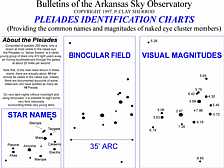
Use This Chart to Determine Stars of the Pleiades which can be seen with the Naked Eye, Binoculars and Finderscopes
-------------------------------------
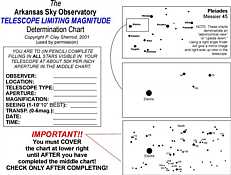
Use the Above Chart to Determine the Limiting Magnitude of Your Telescope
-------------------------------------
But, in addition to these wonderful star clusters which will be discussed individually in our "GO TO" TOUR objects, the field of Taurus offers splendid viewing, whether one uses the naked eye, a good pair of 10 x 50 binoculars or a huge telescope. Unfortunately I am able to only select a few of the finest objects to discuss in our Taurus "GO TO" Guide; I very much encourage all telescope users to obtain the three-set copy of Burnham's Celestial Handbook for reference on each and every constellation; there is no finer reference work for deep sky viewing to be found.
Also note that a wonderful program is now available for you to install on your computer to CONVERT the epoch 1950-1960 coordinates listed in the Burnham reference tables DIRECTLY to epoch 2001: http://groups.yahoo.com/group/lx90/files/Field%20References%20%26%20Techniques/Coordinates.zip which you can unzip and install within minutes....all you must do is merely type in the coordinates exactly as they appear in Burnhams and enter, with the resulting 2001 conversion done instantly for use with your Autostar or NexStar controller! This wonderful tool was made possible by a program posted on the Yahoo LX 90 site originally and offered as freeware by Meade LX 90 user Ron Gardner.
Once scanning the pages of Volume 3 of Burnhams, you will quickly see the quandary one is put into when selecting the "best" deep sky objects and particularly the "best multiple" and unusual stars for discussion. There are no less than 100 fine multiple stars within reach of most amateur telescopes, many of which are fascinating objects. A few have been selected here. In addition we of course have our two closest star clusters as noted above and discussed later....AND, lest we forget, the very FIRST Messier Object....the "Crab Nebula", M-1.
----------------------------
Taurus is one of the most-referenced of all mythological constellations and is one of the original 48 constellations as cataloged by the Greek philosopher/astronomer Ptolemy in the 2nd century A.D. and has the distinction of being the second of the "Zodiacal Constellations," the twelve star patterns through which the ECLIPTIC - or apparent paths of the sun, moon and planets as seen from Earth. In most legend, it has always been assumed or inferred that the horns of the great Bull are aimed in pursuit of Orion, the Hunter to the animal's east; indeed, as can be seen in the two old charts from star atlases of Bayer (1603) and Bevis (1750) the curved and ominous horns are most definitely aligned to a defending Orion (not seen in chart).
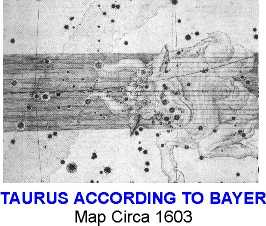
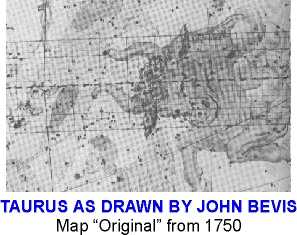
Look at these two charts carefully. There are significant differences, aren't there? But does the one of the Right by John Bevis look awfully similar to the original drawn nearly 150 earlier by the famous celestial cartographer Bayer? In Bevis' drawing, you can faintly make out the club of Orion immediately left of the lower of the two horns of the bull. Although originally posted by Bevis in 1751 as an original set of charts (some indeed were), one need only look at the "cartoon-nature" of the image of Orion in the original sets (it is likely that you will not be able to make this out in this digital reproduction) to realize the tremendous difference in the artist's hand. There was considerably more freedom in plagiaristic borrowing 250 years ago than today.
but....back to the Bull and mythology. It is interesting to note that we MAY be witnessing through historic legend more importance on the bull's HORNS than on the animal himself. This is true throughout Arabic, Oriental, Egyptian, Mesopotamian and even Greek,Roman and even Native American cultures, even without apparently literary exchanges between these early advanced cultures.
An animal's horn - whether it be from the bull, a ram, goat, or Walrus - was a dominant symbol of fertility and bountiful riches in these cultures for thousands of years. In addition, the tip of the bull's horns would have served as the precise calendric indicator for the Vernal Equinox as it occurred at around 4000 BC, just at the height of the Egyptian empire and the emergence of Native American art and culture in the western hemisphere. The constellation Taurus is also key to the Greek mythology of Europa, daughter of the king Agenor, and a great Bull. As the story goes, Princess Europa went to the seashore to gather flowers with her entourage of escorts, handmaidens of the kingdom. Being in love with this beautiful young woman (as he apparently was with EVERY beautiful young Greek woman) the great god Zeus had been watching this field trip from above and decided to "make his move" on the young woman. To disguise himself and venture near Europa, Zeus transformed himself into a magnificent white bull, and as such he mingled in grazing herd near the meadow where the flowers were being picked.
Being so beautiful, Europa did not scare any of the great animals of King Agenor's herd and they were like sheep to her glance, and while looking over the great and gentle beasts, she spotted the unusually wonderful and white one.....Zeus in disguise! The story is very familiar to most of us that Europa turned her flowers into wreathes for the white bull, wrapped them around his horns, and begin to lead him around the meadow. He followed without incident, like a puppy following his mom. In play, Europe decided to mount the large bull and they galloped flockingly up to the seashore, where Zeus (aka, "the bull") suddenly plunged into the sea and carried the princess to Crete. Once there, Zeus transformed (much to the shock of Europa, I am sure!) from the bull into an eagle and became a bit too familiar with Europa, the end results being three sons, the first of which was the famous MINOS. It was Minos' wife, Pasiphae, who had an illicit affair with yet another bull and begat the famous "Minotaur", a half man-half bull creature to whom the Cretans continued sacrifices until the animal was completely destroyed by Theseus (no kin to Roget's Thesaurus).
Minos is said to have introduced the bull cult to the Cretans. He had Daedalus build a labyrinth in the depths of his palace at Knossus, which became the home of the Minotaur (offspring of Mino's wife Pasiphae, and a bull). Seven young men and seven maidens were ritually sacrificed to the Minotaur until Theseus killed it. Minos, in fact, was the title of the ancient rulers of Crete, and the story probably tells of their mythic origin. From this, and throughout even earlier cultures as attested by the symbolic imagery of horned bulls in the 40,000-year-old cave drawings in Lacaux, France, the association of the mighty BULL as royalty or even god-like has persisted. Indeed, many cultures throughout both time and location have worshipped through sacrifice the horned bull as a religious rite, a practice that does continue today.
The head of the bull and the horns themselves - and NOT the bull - are pretty much all that is represented by the stars of the constellation we recognize today. The left (southern) horn starts begins near The Hyades, of which Aldebaran is included (but NOT a part of the actual Hyades cluster!). It extends from Aldebaran to zeta Tauri, near the eastern edge of the constellation, a star known to the ancient Chinese astronomers as "Tien Kwan", or the "gateway to heaven." The right (northern) horn angles up just west of the Hyades, from delta Tauri through tau Tauri and ends at EL NATH, or beta Tauri (we discussed this star as not being part of the large pentagram of Auriga!). As imagined in the two early charts shown above, all else that is shown of the bull is part of his upper body and two very disproportionately thin front legs. It may be that the bull that we are supposed to image the bull as half-emerged in water since on his back he carries Europa across the sea to Crete.
TAURUS (pronounced "TAW-rus") is dominated by the Hyades so far as easy recognition of this star pattern; from mid-northern latitudes, the Hyades rises at about 9 p.m. local time on October 5, crosses the meridian (as high in the sky east-to-west as possible) about 3:45 a.m the following morning and does not set until that afternoon. Midnight culmination (highest point at midnight) occurs each year almost exactly on December 1.
THE STARS OF TAURUS -
For a very comprehensive and complete listing and cross-reference of Bayer, Flamsteed, SAO,double and other star information for the constellation of Cassiopeia, I highly recommend that you visit: http://www.gatter.demon.co.uk/data/Tau.htm .
OBSERVING THIS CONSTELLATION WITH BINOCULARS -
For those who wish to explore the regions of Taurus in binoculars I highly recommend a standard good quality 7 x 50 or 10 x 50 glass used in very dark, moonless skies away from artificial lighting. Remember to let your eyes become "dark adapted" for at least 15 minutes prior to searching out fainter objects. For a wonderful selection of binocular tour objects, visit http://www.dibonsmith.com/tau.htm , a tremendous guide by Richard Smith from his web page entitled "The Constellations."
--------------------------------
GETTING STARTED -
As with every "GO TO" TOUR guide, each GO TO object in TAURUS is discussed for your telescope regarding the type of conditions necessary for you to view it optimally for discern the very faintest details.........magnifications and aperture necessary for most objects, and much, much more. This is YOUR complete GUIDE to get you on your way to exploring the best (and few!) objects in this small constellation. The chart provided above from the Arkansas Sky Observatory and the subsequent detailed listing of "BEST" objects contains the finest or most interesting from my own observing experience and preference.
Use the attached star chart and the following Guide as an excellent reference for your next star party itinerary, or a beginning for further study into the thousands of objects visible in this part of the sky. To access and print the chart, double click on it and save the image to a file on your computer. Once saved, open the file and RESIZE this image to fit the normal paper format for your program and save again....then merely print out the chart on high quality paper for a field reference in this GO TO TOUR!
Every deep sky object and every double/multiple star will have a "PERFECT MAGNIFICATION".....this is the magnification that you should use that will show the object as bright and with as much as detail with possible and still increase its size appreciably so that you can view it comfortably and unmistakably. The rule for determining "optimum magnification" is that: 1) too low power results in sky background glow detracting or diminishing the contrast against the deep sky object; 2) too high magnification darkens BOTH the sky background AND the object; 3) medium magnification can be achieved at which you have MAXIMUM contrast between the object and its darkened background sky. I have found through three decades of direct observing that about 15x per inch aperture (36x for the ETX 60/70; 55x for the ETX 90; 75x for the ETX 125; and, 125x for the LX 90).for deep sky observing is PERFECT for most objects. That being said, always remember that DOUBLE or multiple stars require whatever power you can crank out....the seeing conditions are the limiting factor here.
For my complete and comprehensive discussion regarding seeing conditions and sky transparency, see: http://www.weasner.com/etx/buyer-newuser-tips/seeing.html .
With all deep sky objects, avoid attempting to observe when the moon is in the sky, even a very thin crescent, as its brightness in the sky will overshadow the very dim contrast afforded by even the brightest deep sky object; if you see the object at all against moonlight, you will NOT see the subtle outlying areas or the full detail of what is presented.
For detail descriptive lists of the great double stars within Cassiopeia, and as with all of the "GO TO" TOUR constellation lists, I recommend a good star atlas and/or chart which will list all the finest objects, constellation-by-constellation. One very handy reference guide is the PETERSON FIELD GUIDE TO THE STARS AND PLANETS, which features complete lists with declinations, right ascensions, magnitudes, and all pertinent information for you to expand your observing horizons beyond this brief GUIDE. For the many double and multiple stars, I again urge you to refer to the indispensable "Burnham's Celestial Handbook", Volume 3 for a complete abbreviated listing.
Truly these extensive Constellation Study Guides will most definitely put your AutoStar to work for you in the most efficient and enjoyable way possible! As a matter of fact, MANY AutoStar users are now programming their own "Tours" based on these guides, using each constellation as a separate GO TO Tour for the AutoStar library that can be added in or deleted through the main edit screen on your PC or MAC computer.
We hope you enjoy these comprehensive GUIDES to touring the constellations via your AutoStar and its computer-driven telescope. Each new installment is complete with diagrams, charts and illustrations that you will find nowhere else. Please let us hear YOUR feedback and your observations of each and every constellation after YOU have toured its vast reaches of our skies!
-----------------------------------
YOUR TAURUS CONCISE DIRECTORY OF INTERESTING OBJECTS -
As mentioned, Taurus awaits the curious and discovery-driven observer with a wealth of fine double and multiple stars (for a full discussion on double star observing and their "Position Angles" refer to my brief overview in the "GO TO" TOUR guide for Lacerta: http://www.weasner.com/etx/ref_guides/lacerta.html ) and some outstanding galactic clusters and the most famous (albeit NOT the brightest nor most interesting!) planetary nebula of the skies.
As an added bonus to this installment of the Taurus "GO TO" TOUR a complete discussion of the star clusters Hyades and Pleiades is presented in depth to enhance the efforts of dedicated observers.
The most interesting 11 targets in the constellation have been chosen for this TAURUS "GO TO" TOUR; as with all GUIDES, all objects listed below will be visible in most telescopes (some naked eye) from the ETX 60 through the LX 90; of course larger apertures may "show" an object a bit closer and "better," but frequently a wide field and low power view is more desirable than aperture for FINDING the objects initially. Indeed, I strongly encourage you first FIND the target object, or its approximate location through your GO TO function with your lowest power and then - once IDENTIFIED positively - move up slowly in steps with magnification if necessary. Remember, not all objects "like" magnification. Sometimes better "field of view" (such as the wonderful wide fields provided by the Meade ETX 60 and 70) is desired over light gathering and magnification of larger telescopes.
Note that your AutoStar may NOT have every object listed on every constellation GO TO tour....this is intentional. You can access some of the most interesting objects of the sky directly from their coordinates. It is quite simple as you merely enter these coordinates as follows in the 10-step process:
1) Press the "MODE" key and hold down for 3 seconds and release;
2) Displayed will be the current Right Ascension and Declination of the center of field of view of where your telescope is presently pointed (assuming that you have properly aligned from "home position");
3) [NOTE: if you have the Meade electric focuser attached to any of the ETX or LX telescopes, holding down the "MODE" key will bring up the "Focus" command first....merely scroll (lower right scroll key) down one step to access the RA and DEC to enter your desired coordinates]
4) Press the "GO TO" button on AutoStar;
5) This will change the display and you will note the cursor blinking over the first digit of RIGHT ASCENSION (R.A.); merely use the number keys and dial in the R.A. of the object you are searching for;
6) When done, press "Enter;"
7) This moves the blinking cursor over the "DEC" coordinates;
8) [NOTE: the declination, unlike R.A., can be either positive or negative and you will see the "+" or "-" sign displayed depending on where your telescope is aimed at that time; if it is NOT the desired setting (plus or minus), merely use your arrow key to move the blinking cursor OVER the "+" or "-" sign and change by using either of your lower corner SCROLL KEYS;
9) Proceed to enter the DEC using number keys;
10) Press either "Enter" or "Go To" when finished and the telescope begins slewing to your desired object!!
The constellation tour Star Chart above (click on and save to a file on your PC; then open it and re-size to fit the page and print for a very handy at-the-scope star chart) will get you started on your journey for this constellation.
Following is the concise object list for your "GO TO" TOUR of TAURUS; you may wish to find many of the objects from the AutoStar Library (for example, you can easily go the Pleiades, Messier 45, if you pull up "Object/Deep Sky/Messier Object/..then type in '45'...." and then press "Enter", followed by "GO TO" to access this rich cluster. If your telescope is accurately positioned and level, this should take you to a point nearly midway between ALCYONE AND MEROPE. On the other hand, if you want to experiment and become a "better AutoStar user" try entering the exact R.A. and DEC coordinates of the Pleiades as given below after holding down the MODE key. You will find the accuracy of entered GO TO's to be somewhat less than those stored in AutoStar, but the capability of acquiring unlisted objects is fantastic!
You can also access this cluster (and many other objects) in other ways. It does NOT have an NGC designation, but it is listed under "DEEP SKY / STAR CLUSTERS" and also under "NAMED OBJECTS / PLEIADES".
You will access your FIRST GOTO target - (usually the brightest star in each constellation) - via the command "SETUP / OBJECT / STAR / NAMED....and scroll to "ALDEBARAN", then press "Enter" and subsequently "GO TO" to move your this bright star.
You may also access the constellation by: SETUP/OBJECT/CONSTELLATION/"Cassiopeia".....Enter....GO TO, which will subsequently take you to the brighter star ALDEBARAN, which is the unmistakable red "eye" of the fierce and seemingly angry bull (with Europa on his back on his way to Crete, why should HE be angry??)
** IMPORTANT NOTE FOR AUTOSTAR, LX 200 AND NEXSTAR USERS ** Beginning with this constellation installment, all COORDINATES for celestial objects will be Epoch 2001, converted from standard and pre-existing star/object data from the most recently (epoch 1950, the standard on which most current star reference guides were based). This change will make your GO TO's far more accurate in the future, as the Earth's PRECESSION in space has caused significant shifting of the apparent placement of objects within the past 50 years!
OBJECT 1:
bright star - ALDEBARAN (alpha Tau) - R.A. 04h 36' / DEC + 16 31 - Mag: 0.85 - "The Eye of the Bull"
OBJECT 2:
star cluster - HYADES (Mel 25) - R.A. 04h 17' / + 15 31 - Collective magnitude = 0.8, 40 stars (Aldebaran is NOT one of them!)
OBJECT 3:
star cluster - PLEIADES (Messier 45) - R.A. 03h 47' / DEC + 24 07 - Collective magnitude = 1.4, 130 stars, "the Seven Sisters"
OBJECT 4:
double star - 7 Tauri - R.A. 03h 35' / DEC + 24 28 - Mags: 6.2, 6.7, & 9.7 - primary pair tough even for 8", third star easy with 3" scope!
OBJECT 5:
5" test double star - 47 Tau - R.A. 04h 14' / DEC + 09 16 - Mags: 5.1 & 7.3 - A great double star test for a 5" and larger scope!
OBJECT 6:
3" test double - 80 Tau - R.A. 04h 30' / DEC + 15 38 - Mags: 5.9 & 7.9 - 1.6" separation, good test for 3" scope...nice stars!
OBJECTS 7:
multiple stars in Pleiades! - Messier 45 - (use "DEEP SKY/ NAMED OBJECTS) - 5 nice multiple stars here! Use the following chart for "Object 7"
OBJECT 8:
wild variable star - RR Tauri - R.A. 05h 40' / DEC + 26 23 - Mag: 9.1 to 13 - wildly fluctuating star...maybe a 95 day period!
OBJECT 9:
nice galactic cluster - ngc1647 - R.A. 04h 46' / DEC + 19 04 - Mag: 6.5, very large with 25, 8th mag. stars, nearly due E. of Hyades. Low power!
OBJECT 10:
galactic cluster - ngc1746 - R.A. 05h 04' / DEC + 23 48 - Mag: 6, actually TWO clusters, 50 stars all about 8th magnitude.
OBJECT 11:
the CRAB NEBULA - Messier 1(ngc1952) - R.A. 05h 35' / DEC + 22 01 - Mag. 8.4, very large and very difficult object; not much detail.
OBJECT 12:
planetary nebula - ngc1514 - R.A. 04h 09' / DEC + 34 46 - Mag. 10.5 - Very difficult nebula but 9th mag. central star should be easy!!
----------------------------------
YOUR VISUAL GUIDE TO DEEP SKY OBJECTS IN TAURUS
Object 1 - Our "Starting" Bright Star - "ALDEBARAN" (alpha Tau - pronounced: "al-DEB-aron")
At a magnitude of 0.86 and fiery red, Aldebaran is the 13th brightest star of the sky and has been associated with many legends and designations throughout history, but perhaps none so famous and memorable as "the eye of the bull" in reference to the great bull raging horns-directed toward Orion. Highest in the sky in early December midnights, this star is positioned in the southern regions of the large naked eye cluster Hyades (see below), but is NOT one of the stars gravitationally bound by the stars within that group. Whereas the Hyades is the closest star cluster to Earth, Aldebaran is still closer at a distance of only 68 light years, or about half the distance to the bright cluster. Claudius Ptolemy - the "namer of the original" 48 constellations - perhaps borrowed from the ancient Babylonians in referring to this star as "the torch bearer" or the "...star leading all other stars" in their courses across the sky. Because Aldebaran is conveniently located amidst the ecliptic - the band of sky in which the sun, moon and planets pass from our line of sight here on Earth - it is occasionally OCCULTED, or "covered up" by the moon in its eastward path. It is one of only three first magnitude stars that can be so occulted.
If you are using the 8" or larger telescope, look for a true physical companion to Aldebaran, at magnitude 13.1 about 32" arc (about 2/3 the size of Jupiter in the same eyepiece....use medium power) to Aldebaran's east and just a bit south. Block the bright glare of Aldebaran to see this clearly red dwarf star at its best. About four times that distance from Aldebaran to the NORTHEAST is an 11th magnitude "optical double" star that is not a true companion to the bright star....this star should be seen in even a 3" scope under dark skies.
Object 2 - HYADES - Mel 25 - (pronounced: "HIGH-a-deez") The Closest Star Cluster to Our Solar System!
This system of only 40 odd stars seems more dense than the actual numbers indicate. Remember that this wonderfully large star cluster is VERY close to us (some 130 light years distant....the closest of any deep sky object other than stars) and that MANY of the stars that are actually distant background objects to the naked eye and binoculars that appear to be part of the cluster are what we refer to as "line-of-sight associations" and not part of the 40+ star cluster, of which all stars are bound gravitationally to one-another. In addition there are a few stars - Aldebaran of course is the best example - that are also FOREGROUND objects in between us and the more distant cluster. In any case, the chart provided below shows the NAKED EYE stars (in RED) that ARE visible without optical aid for those with very dark high altitude skies, no moonlight and good eyesight. Those stars indicated with a BLUE number are fainter stars that will be seen in standard binoculars or a good finderscope. Extensive testing over the years has revealed that a trained observer under such circumstance CAN detect stars in our modern artificially light and polluted skies as faint as magnitude 6.2! The following chart I have prepared provides star magnitudes WITHOUT a decimal point (to avoid confusion of the decimal as a faint star!); hence a star showing as "59" is actually magnitude 5.9.
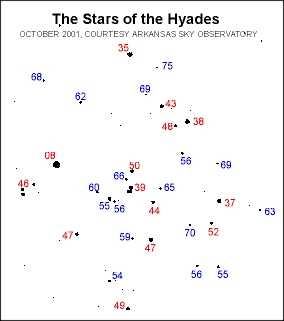
As we mentioned concerning Aldebaran's placement in the paths of planets, sun and moon, the Hyades stars are similarly - and much more often - occulted in spectacular fashion - by the moon; this is particularly rewarding for low power wide field observing (and timings of star disappearances!) when the moon is in its waxing stages and it is the dark, unilluminated limb of the moon that will intercept the star's light and subsequently result in that light "blinking" immediately out of sight!
The Hyades, from the constellation's character standpoint, is predominantly the stars which comprise the HEAD and HORNS of the bull, extending almost 5 degrees east-to-west. It is the unmistakable "V" shape seen naked eye when peering upward in late night skies on fall evenings, the Pleiades looming just north of this larger cluster. To the trained eye there should be about 26 or maybe 27 stars which can be seen without the aid of a telescope or binocular, these being from magnitude 3.34 to 6.65.
In early Roman times, the grouping was known to the layman as "little pigs," apparently confined to a small pen, whereas in oriental texts and very old Greek references, the grouping was significant in association with rains, storms and violet weather. Greek mythology did not ignore the beautiful Hyades, designating them as the daughters of Earth-holder Atlas and his wife Aethra....the same maidens who cared for the all-important newborn Bacchus who would later become the god of drink and merriment, and thus VERY important in the social scheme of things.
The Hyades is best observed in binoculars; the naked eye cannot reveal the rich nature of the star field in and around the cluster; on the other hand telescopes cannot span the needed 4-degrees of sky necessary to bring the entire group into one wide field of view. A standard pair of good binoculars on a good night will reveal ALL 40+ stars to this cluster.
Object 3 - The PLEIADES - Messier 45 / the "Seven Sisters" - (pronounced: "PLEA-a-deez") Our Second-Closest Star Cluster to Earth!
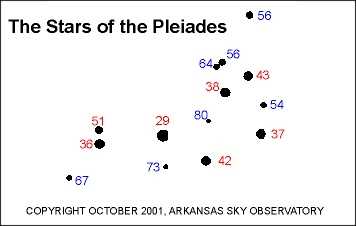
This finder/locator chart is identical to that provided above for the Hyades, and will serve to assist you in determining which stars can be seen 1) naked eye; and 2) in binoculars. The RED stars are those visible (under ideal conditions) with the naked eye, while the BLUE stars are those visible in binoculars; for telescopic tests of limiting magnitude, refer to the extensive test charts shown very early in this "GO TO" TOUR guide.
The photograph below was taken with a guided 200mm f/4 telephoto lens riding piggyback atop an ETX 125 on SAO 155 film for 20 minutes. It shows pretty accurately the view that you might expect of the Pleiades on a very dark mid-winter's night through a good pair of binoculars or very low power, wide field telescopic field. This is one object where the smaller telescope really shines over larger more narrow field instruments!
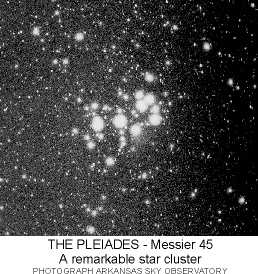
The Pleiades is second only to the Hyades (above) in proximity of deep sky objects; whereas the neighboring Hyades is only 130 light years distant and more sparsely populated in stars (only 40), Messier 45 contains a whopping 625 or so stars from magnitude 2.8 (ALCYONE) to less than 14th magnitude (see the "Limiting Magnitude" chart discussed much earlier in this "GO TO" TOUR). The actual number of these stars which have been confirmed as physical members of the cluster is about 250, but more of those seen are surely associated as well. Its distance is well known at 410 light years and the cluster is actually drifting as a group through space in a southeast direction as viewed from Earth. Within the Pleiades are MANY multiple stars, five of which are featured as "OBJECTS 7" (below) in our GO TO guide for Taurus. In addition, the darkest of nights and the finest of wide field optics WILL reveal the famous "Merope Nebula" surrounding that bright star (see chart above to identify Merope). It can be seen with about 20x in a 3" telescope; increasing magnification will merely make this object appear vague and ultimately disappear from lack of contrast against the background sky. A moonless and very dark night are required and only attempt to observe this nebulosity when the Pleiades is nearly overhead.
How many Pleiades stars can YOU see with the naked eye? Many observers (before light pollution and smog) were routinely able to plot as many as 13 to 15 of the brighter members; known also as the "Seven Sisters," the "Hen and six chicks" from the Bible, and by a series of seven distinct dots enclosed in a circle by the Native Americans of North America as well as the Aztec and Toltec Central American cultures, today ONLY SIX of these stars appear prominent...so what happened to the seventh? Being a very YOUNG star cluster (about 20 million years old....just a pup in the celestial scheme of things), it is possible that one of these active and energetic stars has stabilized a bit and decreased in intensity in recent centuries. For more information on observing this wonderful star cluster, visit my observing guide at: http://www.weasner.com/etx/buyer-newuser-tips/pleiades.html .
The distinguishable shape and brightness of this unique cluster have predictably given rise to much lore and legend by association. The earliest Chinese celebrate the "Feast of Lamps" in honor of the "seven lamps" of the sky, while native Americans worshipped the stars as part of the famed Devil's Tower in the plains of Wyoming. In Biblical references, the Pleiades have been linked to the plagues that infested Egypt, while the earliest Greek stories tied this innocent group of stars to such events as the sinking and eventual disappearance of the fabled land of Atlantis.
As mentioned with the Hyades and the bright star Aldebaran, the Pleiades is ALSO frequently occulted by the moon, as very spectacular and rewarding sight for even seasoned stargazers; such events are usually announced far in advance on various Internet calendars of celestial events and in popular publications such as Sky and Telescope and other periodicals.
Object 4 - A Nice but Difficult Triple Star - "7 Tauri" - Two easy.....the third, well: TOUGH
Seven Tauri is listed as a triple star by Vehrenberg and others, but is noted as only a double by Burnham. This is an unusual situation for a triple star in that the two brightest components are the most difficult to differentiate, while the fainter third component (magnitude 9.7) is an easier target about 23" northeast of the brighter 5.9 magnitude combined brightness of the two primary stars. The star 7 Tau has a VERY close companion at 0.6" arc nearly in the same direction (Position Angle 23 degrees, or about NNE) as the fainter star (Position angle 58 degrees) refer to the chart below to locate these stars relative to one-another. The two primary and closest stars CAN be resolved on the best night with an 8" or larger telescope; the third star is easy with the 3" and larger apertures.
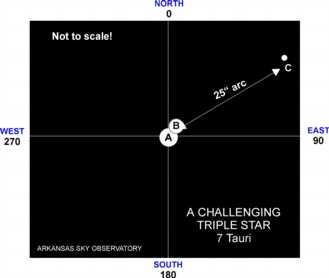
Object 5 - An Easier, but Still Not "EASY" Triple Star - 47 Tauri - Great test if you think your 5" or 6" scope has killer optics!
Can your 5" scope surpass Dawe's criteria? Divide your telescopes aperture in inches into the value "4.54" and that gives you the theoretical resolution in arc seconds (") that your telescope can resolve double stars of equal magnitude under perfect seeing conditions. For a 10" scope, for example, that would yield a value of 0.45" arc. In a 5" telescope two stars would have to be separated TWICE that much (or about 0.9" arc) to be cleanly split under the same conditions. The star 47 Tauri has a separation of just about that: 1.0" arc for its two primary (brighter) components and is a tough object. Look for two stars extremely close, almost "touching" nearly north-south-oriented; the fainter star (magnitude 7.3) will be almost due north of the brighter star (magnitude 5.8). This will be a test for scopes in the 4" through 6" range. A third component, magnitude 12 and barely visible in those telescopes but easy in the 8" and larger, is located southwest of this pair a full 30" arc.
Object 6 - Okay, Another Double: 80 Tauri in the Pleiades - This one is a challenge for the 3" aperture telescopes!
Here is a very nice double star for the 3" aperture telescopes and larger; it is an easy target at medium-high (150x) magnification in the 5" and larger instruments, but will be tough in the 3" with a separation of only 1.6" arc, somewhat wider than the theoretical limit of 1.3" for a 90mm scope. This will be an easy star to locate at magnitude 5.9, with the magnitude 8.9 companion very close and just east of due north from the brighter star.
Objects 7 - Double Stars in the Pleiades and Hyades!
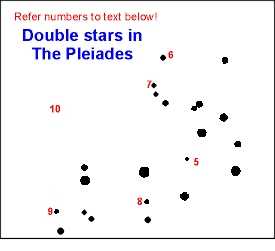
We have explored the Hyades and Pleiades already. These clusters we have seen are an excellent indicator of the ability of the naked eye to see faint stars, and to judge the limiting magnitude of optical instruments as well as the human eye. We have noted the proximity, ages and motions and discussed the faint nebulosity that is still "hanging around" from the Pleiades emergence through its primordial gas and dust cloud. With perhaps as many as 500 stars in the Pleiades and 50 in the Hyades which likely are bound through gravity in these clusters, many are sure to be "multiple stars" or double stars as we have just seen in the preceding objects....in addition to being part of the entire "multiple group" of the clusters themselves! I have selected some true physical double stars in each of these clusters (including again 80 Tau, discussed above). Use the chart above to locate the fainter stars in the Pleiades and attempt to find the brighter and easier stars that I have in the first list (Hyades) via the COORDINATES (R.A. & DEC - epoch 2001) that I provide at the end of each star description. Note that most of the first four (HYADES) are easy targets for the smallest telescopes; these are TRUE binary stars,and not just merely aligned to one-another in our line of sight as might be other close by stars. The second five stars (PLEIADES) are more challenging, fainter and closer for good challenges with your telescopes! Note that the number preceding each multiple star coincides with the number in RED on the chart above!
*** these are all easy and bright stars to locate in the Hyades! ***
1) -Theta2 (magnitude 3.4) and theta1 (magnitude 3.8) - wide separation of 337" arc, theta2 just below and to the east in PA 346º. Easy in all telescopes. (R.A. 04h 26' / DEC + 15 58)
2) - kappa2 (mag. 4.2) and kappa1 (mag. 5.3) - an easily resolved binary with separation of 5.3" arc in PA 328º (nearly north-south orientation). (R.A. 04h 25m / DEC + 22 15)
3) - Sigma2 (magnitude 4.8) and sigma1 (magnitude 5.2) - very wide separation of 431" arc - another wide binary in PA 193º , or almost north-south orientation. (R.A. 04h 39m / DEC + 15 47)
4) - 80 Tauri is a difficult double star which is currently at nearly its maximum separation (see OBJECT 6, above). (R.A. 04h 30m / DEC + 15 38)
*** now for some harder/fainter ones! Use the Pleiades chart above for these five! ***
5) - Burnham 536 - (magnitudes 8. 9.5, 8 - triple) - very close (0.6")primary pair oriented N-S, third component SW wide 39" arc
6) - Burnham 537 - (mag. 8.5 & 10.5) - very close (0.9") stars in N-S orientation; tough for 5" scope, not easy in 8"
7) - Stuve 449 - (mag. 8.5 & 11) - wide pair (6.8") but secondary star (NW of primary) is pretty faint....good test for 3" and 5" scopes!
8) - Struve 450 - (mag. 7 & 9) - nice double and easy, with 6.1" separation; fainter star is due west of primary
9) - O. Struve 64 - (mag. 6.5 & 6.4) - tough at 0.6" for 8" scope; look for equal pair in nearly N-S orientation!
Object 8 - A Very Wild and Erratic Variable Star: RR Tauri
As can be immediately seen by the light curve plotted below which covers a span of time covering 250 days, this is no ordinary star. RR Tauri will be a very difficult star to monitor throughout its entire light cycle with all but the 5" and larger telescopes since at minimum it dips into the low "12's" in magnitude and sometimes as faint as magnitude 13.1; however the ETX 125 should be able to following this star's peculiar outbursts and declines very well.
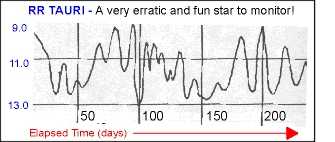
Note that the sudden increases to maximum as well as the downfalls to minimum light can take place in a matter of only a day or two! There is an indication of some degree of cyclic nature to RR Tauri's light changes of about 95 days, but that does stretch the imagination somewhat; at a distance of 3000 light years, the star might be similar to the "Orion-type" very young stars that are attempting to achieve thermal equilibrium.
To locate this star download the chart charts.aavso.org/standard/ORI/U_ORI/UORI-A.GIF which is the "a" finder chart for the star "U Orionis" and also includes the position for your finderscope for RR Tauri. This and other fine charts are available from the American Association of Variable Star Observers (AAVSO) with whom you can make contact via www.aavso.org to learn more about how to observe and contribute your estimates for the hundreds of variable stars for which amateur astronomers contribute nearly exclusively for each year. When the star reaches its faintest point, you will need the chart charts.aavso.org/standard/TAU/RR_TAU/RRTAU-DR.GIF , the "d" or very narrow field and higher magnification chart which provides comparison stars down to magnitude 14. Note that this latter chart is also a "reversed" chart that the AAVSO has released to match the field of view of your telescope, with NORTH up and EAST to the right.
Merely right click on the chart and save it to file on your computer; call up the file and resize it to fit your standard 8.5 x 11 inch paper size and re-save in that new format. Then simply print out each of these charts, laminate for outdoor use and observe away! (see my complete discussion on variable stars at: http://www.weasner.com/etx/ref_guides/variable_stars.html )
Object 9 - Very Large Open Cluster - NGC 1647 - Just East of the Hyades
This is really an ideal object for binoculars or for a very low power wide field instrument such as the ETX 60/70. NGC 1647 can easily be found by "sweeping" a wide field of view about 3 degrees to the east of the center of the Hyades; the true "cluster nature"of this 40-star group is lost in high powers and in larger telescopes. The grouping is extremely large (40' arc - larger than the apparent diameter of the moon), so the widest field of view is necessary. Most of the stars are 8th and 9th magnitude, so this is an excellent low power object for small telescopes.
Object 10 - Galactic Cluster NGC 1746 / 1758
Here is a very irregular cluster of stars that actually shares its stars between TWO designated "ngc" listings. NGC 1746 is technically the "western part" of this cluster and NGC 1758 takes up the eastern side. At magnitude 6.0, this brightness is deceiving since that total light is spread out over a huge 45 arc minute area, 1.5 times larger than the moon's disk as we see it in the sky; when you view this with VERY low power, you will realize why this "object" has two designation, with two conspicuous clumpings of 8th and 9th magnitude stars to either side of center. In total there are about 50 sparsely scattered stars in this cluster. This is another cluster that really requires a very low power instrument affording the widest possible field of view.
OBJECT 11 - THE CRAB NEBULA! Messier 1 - The "bright Star of 1054"
Why did Charles Messier ever star his "list" of faint fuzzy objects now known as the "Messier Catalog?" The answer lies in an event that took place over six centuries before the French comet hunter was ever born.
Rising with a very thin crescent moon on the warm summer morning of July 5, 1054 a young Pueblo native American awoke to the haunting howls of many distant coyote, the pups screaming in discordant tones over the wails of their guardians. Throughout the canyon of the Anasazi, creeping through the remote crevices and sweeping through the distant hollows, more and more the cries of wildlife alerted the young man that something was different than it was the morning before when quiet met the impending dawn. To his east the bright fiery red Aldebaran, known to him as another name now forgotten in time, was gently hovering low in the now-brightening deep skies. It was a sight very familiar to him, the pointed shape of a cluster that would become known as "Hyades" in some future time describing exactly the pattern of the many projectile points routinely made by members of his group.
But there was a visitor to all this....heralded by the frantic coyotes, and emblazoned upon the sky with the accompaniment by the waning moon: there was a new star, once that outshone the familiar "red eye" and one that rivaled it in color and intensity, yet so bright that it nearly overshadowed the brilliance of even the moon. Shadows were cast upon the ground by this magnificent sight. So impressed, the Pueblo youth left an artist's image of what he had seen in red ochre smeared via his shaking finger against the flat writing surface of stone in a nearby overhang in the canyon.
The image still remains in Navajo Canyon today, a large circle that seems to encompass the crescent shape of the moon, perhaps indicative of the fact that the unknown object WAS brighter than the moon itself. And he was not alone. The spectacle was recorded around the world, notably by Sung Dynasty astronomers who observed and documented carefully the new visitor to the skies, a "guest star" in their records. With the suppressions of medieval European thought, there is unfortunately NO record of any observations of this "Supernova" from western cultures, although there are references that might indicate some Roman and mid-eastern early historic records of the stellar explosion.
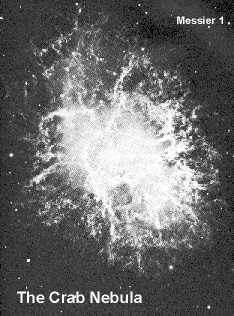
What we see today, and essentially what Charles Messier first saw on September 12, 1758, is preserved in the striking photograph above taken by the Palomar 200" telescope....a planetary nebula. This huge cloud of dust and gas is the primary remains of a great stellar Supernova that result in the virtual annihilation of a great star almost 1,000 years ago. Although photographs today will reveal SOME changes from that seen above since the gases are now flowing outward at the incredible rate of 600 MILES PER SECOND (!), our view remains pretty much as it appears in that remarkable photo. Very large (10" and above) telescopes will reveal some of the faint filaments that you can see streaming from the center of this epic event. However, smaller instruments with modern CCD imaging can easily capture much of the fine structure that is surely representative of the catastrophic nature of this explosion some ten centuries ago at a distance of over 6300 light years away. One cannot look at this photo and not be overwhelmed by the cataclysmic force that created this remarkable view.
In my opinion, the "Crab Nebula" as we know this remaining cloud from the supernova event of 1054, is one of the most difficult of all the Messier objects; the unknowing observer can be peering directly at it and actually not even realize there is an object in the field of view, since its faint 9th magnitude "integrated brightness" is spread out over a large 5' x 3' arc area. It thus has a VERY low overall surface brightness. It can be seen in a 3" telescope under very dark skies,but expect no detail at all until using the 10" and larger telescope. It is recommended to use higher powers on this object, contrary to most practice when observing deep sky objects; I have always found that a magnification of about 35x to 40x per inch is actually ideal for this nebula as well as other planetary nebulae. Always observe this difficult object only when the moon is totally absent from the sky; nebula filters most definitely help on this planetary, but not to the degree that they do on brighter ones such as the Dumbbell (Messier 27) and the Ring (Messier 57).
At the center of the nebula, and the resulting phenomenon from the stellar explosion is a very faint starlike object (magnitude 15.9) that ejects tremendous "pulses " of energy in both radio and X-radiation at the rate of precisely 30 times each second. So accurately and intense are these beats that such a source (and there are many now known) has come to be known as a "Pulsar."
The only reason that Messier even started his famous catalog was because he had confused this faint object for a comet that he was attempting to "re-find" from the night before....as he searched for the comet, he stumbled across this "faint fuzzy," and realized that it appeared very much as do very faint newly-discovered comets prior to brightening and forming the characteristic features such as a tail. He explained, "....I endeavored to find others....in that astronomers would not confuse these [nebulae] with comets as we see them when they first begin to shine..." And the rest is astronomical history.
OBJECT 12 - A Rival Planetary Nebula That Messier never Found - NGC 1514
This is a much fainter, more distant, certainly older and much more difficult object for small telescopes, the planetary nebula ngc1514. This interesting planetary has done a switch on amateur astronomers in that the STAR which created the shell of gas (similar to that of the Crab Nebula) is actually much easier to observe visually than is the gas shell that was ejected! The central star of ngc1514 is magnitude 9.7 (visible easily in a 3" scope) while the faint strands of nebulosity are a very faint 10.8. Thus, it is possible to identify the star from this object, but not the gas planetary nebula unless using a telescope 8" or larger and in very dark skies.
----------------------------------
WANDERING ABOUT....YOUR NEW "USER OBJECT" IN TAURUS
Back to the Pleiades: we have all seen the famous blue nebulosity that surround most of the brighter stars of this remarkable cluster, the most dense and "observable" being that encompassing the bright star Merope. This nebulosity (only that enveloping Merope) is also designated with its own number, "IC 349" and is fairly easy to detect in small wide field instruments on VERY dark nights. I have actually detected it in my 10 x 50 Nikon astronomical binoculars, and it can routinely be see in richest field telescopes utilizing the lowest possible power and widest field of view. The fine photograph of this incredible nebulosity associated with nearly every star of the Pleiades and particularly Merope (arrow) below was recorded with a 3-minute unguided exposure from the wide field 13" f/4 camera at the Arkansas Sky Observatory in 1983, with the wispy clouds of nebulosity appearing as though an artist passed through the pool of gas with a broad paintbrush. The spurious reflection image at left is a flare produced in development of the original cooled emulsion negative.
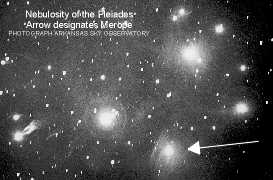
All of this gas cloud that is still visible, and certainly photographable, is what remains of the actual formation of the entire 500-member group of stars. This primordial gas is perhaps not at all unlike that of the equally famous Orion Nebula, except that more gas and less stars remain in the latter object. Eventually we might imagine that all of this remain gas will be "accreted" or gravitationally-tugged into Merope as well as the other nearby stars until none remains. In color photography, amateur astronomers, even utilizing piggyback photography via telephoto lenses can capture the true BLUE coloration of the young energetic and hot stars and the whitish glow of this surrounding cloud of gas.
The star Merope and IC 349 are our "GO TO" TOUR User Object for this installment of this constellation guide. The 2001 epoch coordinates of the star Merope are:
R.A. 03h 46m.2 / DEC. + 23d 24m
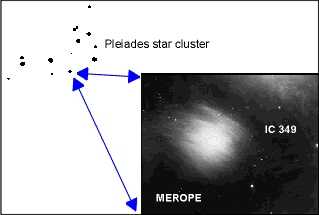
Of course you can use the chart above to find the star quite simply with your finderscope, but it will be quicker to access if you add this star and nebula as yet another of your growing library of User Objects!
On AutoStar, go to: "Select/Object [enter]...." scroll down to "User Object" [ enter]. Now enter the coordinates given above for "Merope", using the number keys on AutoStar. After entering the coordinates and pressing "Enter" yet again, scroll down one and you can list the magnitude of the object as "4"[Enter].
Next Constellation GO TO" TOUR Installment: To got aptly with our whales, dolphins, fish, water monsters, dragons, snakes, and "water bearers" we must at least have some WATER! So we will visit the shores of our celestial river, ERIDANUS, the very large constellation that most of us know very little about, but stretching near 50 degrees from the celestial equator southward....a constellation with NO Messier object (Messier, after all, was located in northern France) but with 25 galaxies within range of amateur telescopes. And....perhaps best know as the constellation that just precedes the fabulous showman of winter: ORION.
Good Observing and may the stars serve as your sentries as you explore the frontiers of space!
P. Clay Sherrod
Arkansas Sky Observatory
Conway / Petit Jean Mountain
Arkansas
Return to the top of this page.
Go back to the Observational Guides & References page.
Go back to my ETX Home Page.